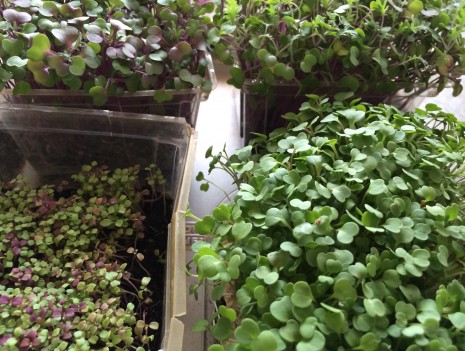A MICROGREEN GARDEN
In another month, the Union Square Greenmarket will be bursting with young greens—not just the ubiquitous ramps, but dandelion leaves and wild edibles such as chickweed, claytonia, and nettles—spring tonics, all.
Meanwhile, I’m getting my fresh fix from microgreens. Unlike sprouts (the first stage of plant growth), which are germinated in a dark, moist environment, microgreens, the second stage, are grown in soil or organic potting mix and exposed to sunlight, so they produce chlorophyll. Once a specialty garnish destined for starry restaurants (find the backstory in this recent TakePart column), you can now buy flats or boxes of them at specialty markets and, increasingly, farmers markets.
They are also easy to cultivate at home (seed-to-harvest is about two weeks), and tending them is peaceful, contemplative work. Just keep them moist and in the sun, then snip them off right above soil level once their first true leaves begin to emerge. You’ll know true leaves when you see them: They follow the initial, embryonic leaves (which are present in the seed before germination) and look more like the mature plant. You can only get one harvest from each planting, but no worries—scatter new seed in the same containers, cover with growing medium, water gently but thoroughly, and be patient.
I’m still getting the hang of sowing seeds in succession, so we have a continuous supply at the ready. In the little garden you see above are, clockwise from top left, red russian kale, some other sort of kale, arugula, and, well, I don’t know, but it tastes like sorrel—the unmarked box was languishing at Lani’s Farm stand at the Greenmarket, and I couldn’t resist. Once the tart, almost sour greens get a bit taller, they’ll be delicious on top of an omelet, broiled fish fillets, or a bowl of schav, or sorrel soup.
Microgreens taste like the essence of the vegetable. They are handy for punching up a sandwich or typical salad, but, more importantly, they are a welcome relief from the same-old, same-old cooked greens. I’ve been playing chef—topping roast chicken or a made-up lunch of canned American Tuna and white beans with a fluffy tangle of herbaceous celery micros, for instance. Peppery arugula micros are lovely with seared top blade steaks or duck breast, and milder cauliflower micros take roasted cauliflower up a notch. The kale micros give a fresh dimension to any number of scratch suppers, including sausage and chickpeas over pasta, a recent favorite.
Even though microgreens are intense in flavor, they are tiny and beautiful, thus powerful lures for children or veg-phobic friends. Don’t break the spell by bragging about how nutritious they are; depending on the type, they have from 4 to 40 times more nutrients than the fully mature vegetable (for more details, see the TakePart link, above). Instead, turn your tabletop garden plot into a centerpiece—and give everyone a pair of scissors.
Where to buy seeds
The sources I mention in my TakePart column are Johnny’s Selected Seeds, High Mowing Seeds, and, for convenient growing kits, Lucky Leaf Gardens and Gardener’s Supply Company.
Posted: April 1st, 2014 under cooking, culinary history, early spring, people + places.
Comments
Comment from Lynn
Time April 3, 2014 at 5:30 pm
I am going to try this. I have a Tower Garden, which I love, and just sowed my organic veggies indoors, and will transfer to Tower Garden outside in a couple weeks. It is amazing how quickly the organic seeds sprout. Very rewarding. Bon Apetit



Comment from Ally
Time April 1, 2014 at 11:38 pm
How very cool. I often see microgreens sold here at the farmers’ markets in Sacramento but had no idea how easy it would be to grow them myself. Thanks!